Cool and Unusual Therapy
by Jazmine Frazier
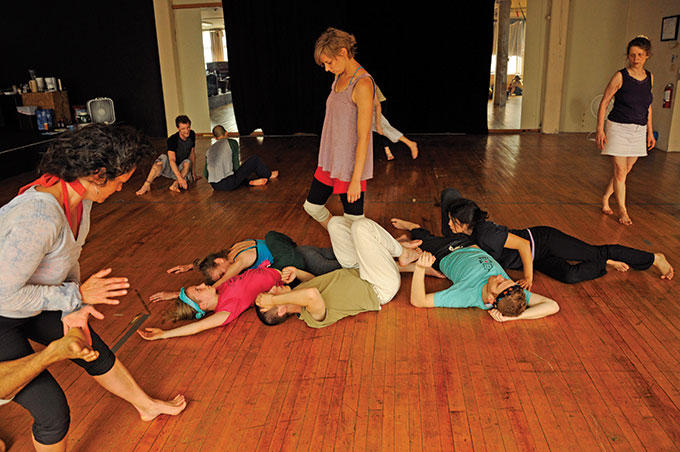
Contact improvisation jams are more than just performances, and they’re not just for seasoned performers. Our intrepid reporter joins the fun…
It’s called a Contact Improvisational Jam. That’s what I call spreading fruit jams onto toast. An unsuspecting audience, watching the dancers roll across one another, thinks, “What?” If you have never viewed one of these dance sessions, you will be asking yourself the same thing.
Buffalo is the secret home to the Buffalo Contact Improvisational Jam Performance Group, the intriguing collective that communicates through movement and movement alone. A “jam” refers to a dance session. The technique is so loose, that someone who has never danced can offer a stimulating twist to the style.
“An advanced dancer can have a legitimate, interesting, and rewarding experience with a completely inexperienced dancer,” says Nancy Hughes, the administrator of BCIJPG, hardly able to contain her enthusiasm.
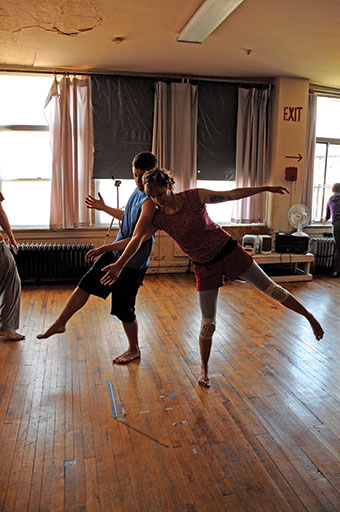
Contact improvisation, by its very nature, is an indefinable dance style, which is what makes it so accessible. Steve Paxton, the creator of contact improv in the 1970s, made the technique specifically vague as to avoid personal power and hierarchy. Although Hughes is widely seen as the founder of the dance company, she prefers to be seen as the group’s “cheerleader.” Her unwillingness to be glorified inadvertently leads her down a similar path of power avoidance as Paxton, and allows contact improvisation to flourish without inhibition.
As a contact improv virgin, my immediate thought while first watching Hughes and Scott Slocum that they had short-circuited, or that something had assumed control of their bodies. After the initial performance, a panting Hughes grinned over a glass of ice cold water and asked me if I’d been watching. She drew a long while from the bar straw. I nodded. I suppose I had just seen them performing.
The two were positioned in the front corner window of Savoy in Allentown this spring, where Yelp was hosting a party themed after The Great Gatsby that attracted a group of 30 or so. Slocum surged through the small sea of party-goers in sideways strides with Hughes following closely beside. The two lunged toward the rear of the building and spun around to push back to the front of the restaurant. Neither allowed the occasional drinking straggler in their path to halt their show. Every obstacle spelled out another potential improvisation. While I waddled without skill through the packed bar area, Hughes and Slocum seem to slither together to the safety of an open area.
The two wrestled (literally wrestled) on the wood floors, in a completely unpredictable tangle. Nancy rolled off of Scott’s back—a move that is called the “tabletop”—apparently uninhibited by her short ivory lace dress. This bit I found almost poetic. I began to understand to concept behind contact improv.
After their last performance, I just had to pick Slocum apart.
“You guys were nuts!” I said.
“Thank you,” he replied. A quizzical look of realization seeped into his eyes. “I think.”
Slocum was obviously delighted that I was stumped as to what the hell their spiel was all about. Or more appropriately, delighted that I was asking so many questions: “Is this planned at all? Do you ever just beef it? Will Nancy hold you in the air whilst spinning in place? Where did you meet? Do you know other styles?”
The questions were frothing from my mouth. He listened attentively and answered thoroughly.
The question “Does someone lead and how do you know where to move next?” led to a brief live instructional. He directed me to hold my hand open-palmed toward him. He aligned his palm with mine and leaned his body into it. I fell back a little. He explained that with contact improvisation, you have to ground yourself through your partner. I leaned forward into him. Our palms were what he called our “contact point.” He forced me in one direction and I pushed back, assuming the lead. He pulled, I followed. I fleeted, he chased.
It’s a game of give-and-take. You have to trust your partner and follow as well as lead. This free-form expressive movement opened Slocum and Hughes to the bewildered but fascinated minglers at Savoy. There was avid talk about the performance during and quite a while after the party dissolved. This fascination led me to seek more information about this strange performance art, so I followed up and arranged a formal interview with Hughes and Slocum at Sweet_ness 7 Café.
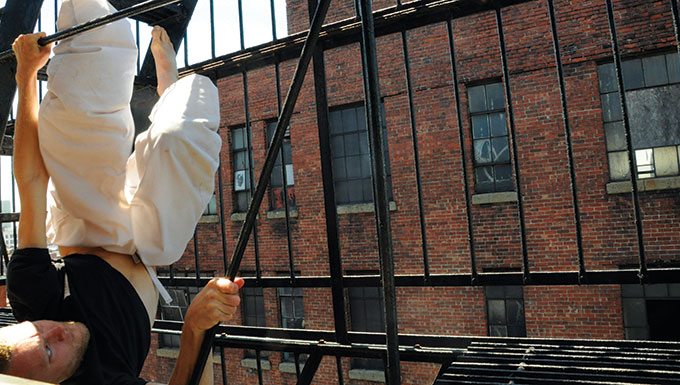
Over green tea, Turkish coffee, a Maine Beer Company porter, and complimentary chips and salsa, the three of us chatted about contact improvisation. Contact improvisation was revived in Buffalo by Hughes, Slocum said, but she was reluctant to assume too much credit. She said that there was a contact improvisation group in Buffalo back in the late 1990s and into the 2000s conducted by a man by the name of Januar Ceil. Hughes’s undertaking started as an open jam class, which still practices weekly, but made way for a new creation: a dance company, Buffalo Contact Improvisational Jam Performance Group. The story of how the performance group came to be opened up as many great campfire stories would. Cheerleader Hughes leaned in magically, with eyes wide:
“One time after a jam on the Fourth of July, four people ended up on the roof of a building…”
The story unfolded to tell the tale of the conception of BCIJPG, as accompaniment to a 360-degree fireworks show. The event was likened to parents finding out they had conceived a child: The baby was in the making, but the parents had no idea what kind of person it would grow to be. BCIJPG became an outlet for experienced contact improvisers, and the troupe has since performed at venues Big Orbit and The Alt.
While BCIJPG grows in popularity, so does the contact improvisation jam class, which is open to anyone interested and normally occurs every Sunday from 5pm until 8pm at 700 Main Street. Hughes and Slocum told me about Tim Greco, an avid participant of these contact jams since October of last year. Greco had decided to host an intensive weekend-long jam the first weekend of June. I, being interested, was invited for the ride.
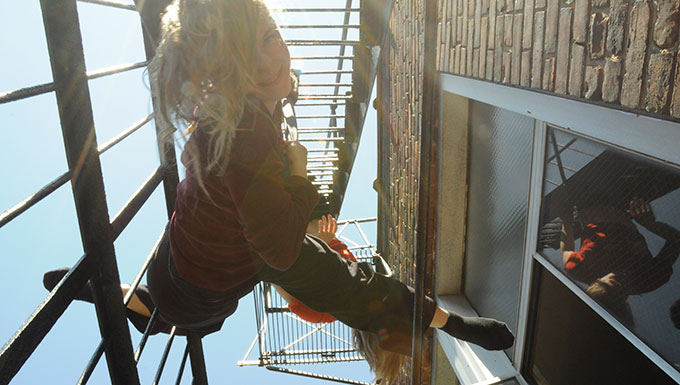
With the weekend event came incredibly vast and nourishing breakfasts, lunches and dinners. There were warm-ups, jams, performances, and an “underscore,” which I attended on a Saturday. For those unfamiliar with dance, there is a score, which is a guideline for a technical exercise. An underscore is a term coined by a Steve Paxton-inspired dancer, Nancy Stark Smith, which explains the course of actions within an extensive jam session.
There are many aspects of contact improvisation that Smith defined in order to keep participants engaged in the underscore itself. All of the stages of the underscore can be found in her book Caught Falling. First in the underscore is “Arriving Energetically,” which introduces the participants to their dancing space and helps them fully immerse themselves in the event. This introduction to the three-hour session was akin to yoga meditation, only you could do whatever you liked—walk, sit, lie, roll—and its intention is to help surrender outside thoughts and focus on the act at hand.
Somewhere in the middle of the underscore, the participants explore their kinesphere, which is the focus on external movement. Overlapping kinespheres is when your movement meets with others around you. This is where the contact improvisation gold is discovered. On the sixth floor of 700 Main Street, the overlapping kinespheres were uncontainable. There was a strict “no talking” rule, but other than that, the possibilities were endless. You could chant, scream, caw, bark, leap, hop, bounce off of eachother, roll over your partner, run around the room, or even lift one another.
Greta Sowyrda, a Buffalo resident and nimble contact improvisation dancer of four years, took part in the weekend jam, too. “I don’t use my muscles to pick people up,” she told me. “It’s about stacking people on my bones.” She said balance is the key to picking up heavier partners.
When explaining how to successfully improvise with a partner, Roy Wood of Rochester, who has 15 years of contact improvisation under his sweat pant drawstring, was full of useful advice as well.
“When you put all of your weight into the [physical] connection, that allows you to do a lot,” he said.
Wood dabbles in the philosophy that contact improvisation helps to rebuild trust between humans when it comes to fear of physical violation. “In America, our culture associates touch with sex,” he said. “[Contact improvisation] is a way to reclaim that view and make it more about communication. You are giving [someone] permission to be in a space [with you]; not sexually, but still have intimacy.”
Looking around the studio, I saw plenty of that intimacy Roy was talking about. Everyone (including myself) was soaked in sweat, dancing like no one was looking…except perhaps their partner for the moment, and even then, many had their eyes closed. Some danced fast and aggressively, and others took a slow, sensual approach. There were partners of varying genders and numbers who were actively engaged in one another, sharing sweat, laughter, and a bond that is completely indescribable to someone who has never tried contact improvisation.
After the intensive underscore, there came what is called the final resolution, where everyone spends what feels about five minutes coming to a concluding pose, then the last stage of “Sharing/Thanksgiving,” which is the circle participants form to discuss and thank everyone for their experience.
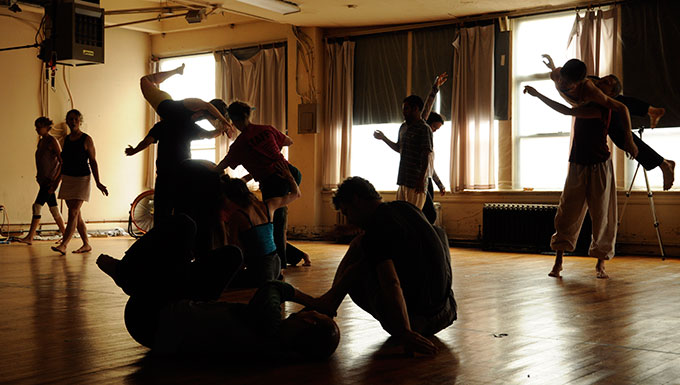
The aforementioned phases I missed, having to depart early. As I gathered my things to leave, I looked out onto the dance floor, then past that to the water droplets forming on the bars of the open windows overlooking the street-lit railway. The rustic building was a piece of art in itself. I felt particularly picturesque in my dance-induced stupor, wearing a borrowed pair of Hughes’s pants, wobbling to my car parked on Pearl Street. I stood at the open door for about 30 seconds with my face toward the wispy royal blue sky, letting the drizzle cover me. I had never felt so glad to be rained on. My adrenaline levels were lowered and I began to feel the affected limbs bruised and twisted. I was reminded of the half-dozen bandages I wore at any given time as a child. I thought to myself, “This is what it must feel like to be a child.” Those days seem so long ago.
I was exhausted. My grown-up troubles were in a far-away land. I felt alive. I am alive. Contact improvisation is unusual therapy. If you don’t believe me, the sixth floor on 700 Main will teach you.
Find more info about contact improvisation at bcijpg.weebly.com.
blog comments powered by Disqus|
Issue Navigation> Issue Index > v12n33 (Week of Thursday, August 15) > Cool and Unusual Therapy This Week's Issue • Artvoice Daily • Artvoice TV • Events Calendar • Classifieds |









 Current Issue
Current Issue